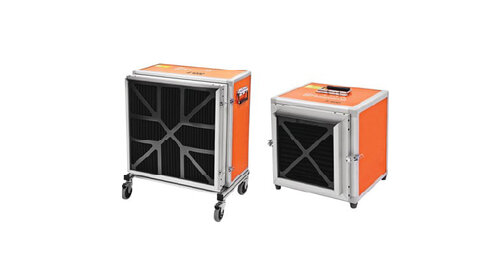In the summer of 2023, dirty air blanketed much of the United States as smoke from Canadian wildfires drifted south. At one point in late June, one-third of Americans lived in areas under air quality alerts.
How do you improve indoor air that’s fouled by smoke, mold spores, concrete dust or other contaminants? EquipmentShare rents portable filtration machines — also known as air scrubbers — that can help you breathe easier.
What Is an Air Scrubber?
“It’s a portable air purification device,” said Frank Borges, the national director of EquipmentShare’s climate control division. “An air scrubber works by drawing in contaminated air from its surroundings and passing it through a series of filters. These filters are designed to capture and remove various types of airborne particles, contaminants and odors.”
The key feature of a portable air scrubber is the high-efficiency particulate air (HEPA) filter.
- A HEPA filter can remove at least 99.97% of airborne particles that are 0.3 microns or larger. For reference, the thickness of a human hair is about 70 microns.
- Air scrubbers come in different sizes, but the most common one is 500 CFM. That means its air flow rate is 500 cubic feet per minute.
- A 500 CFM scrubber is a bit larger than a piece of carry-on luggage and plugs into a standard electrical outlet.
Air Scrubber vs. Air Purifier: What's the Difference?
Air scrubbers differ from the air purifiers typically found in homes in that they are more powerful and louder, and therefore they’re most often used in industrial, commercial and health care facilities. The term “air scrubber” can also apply to large machines that are permanently attached to the HVAC ductwork of homes and businesses, but this story will focus on portable air scrubbers you can rent to deal with temporary indoor air quality problems.
Why Do I Need an Air Scrubber?
Borges said the most common reasons for renting air scrubbers are:
Remediation and Restoration
- Contractors who specialize in cleaning up messes usually own multiple air scrubbers and rent additional ones as needed.
- Scrubbers can help clear the air while workers remove hazardous materials such as asbestos, lead, mold or chemicals.
Demolition and Concrete Work
- Brick, tile and concrete contain silica dust, which can cause lung cancer, kidney disease and other health problems if inhaled.
- Air scrubbers can help trap the dust while workers complete projects.
Wildfire Smoke Elimination
- Managers of retail businesses, warehouses and other buildings rent air scrubbers to keep their facilities safe for employees, customers and visitors.
- To use a scrubber for this purpose, you need to insert a carbon filter in addition to the pre-filter and HEPA filter.
Infection Control
- Hospitals and other health care facilities sometimes use air scrubbers as negative air machines in areas where there are airborne pathogens.
- Ductwork is attached to the scrubber’s exhaust vent to carry air out of the room. That creates negative pressure in the room, which prevents contaminated air from spreading to other parts of the building.
Borges said depending on the situation, air scrubbers are often rented along with other climate control equipment. After a flood, dehumidifiers and fans help dry rooms while scrubbers clean the air. Remediation contractors sometimes rent deodorizing ozone or hydroxyl machines to lessen smoke, mold or pet smells. Note that when working in potentially contaminated areas, you shouldn’t use air scrubbers as a substitute for personal protective equipment (PPE).
How Many Air Scrubbers Do I Need?
To know how many air scrubbers you need, determine the cubic area of your space by multiplying the length, width and height of the room. Then multiply that number by how many air changes per hour you need — that number can fluctuate depending on what contaminant you’re dealing with. Then divide the total by 60 to convert from hours to minutes. That will tell you how many cubic feet per minute of airflow you need.
For example, let’s say you need to scrub the air in a room that is 25 feet wide, 25 feet long and 8 feet tall, with six air changes per hour. The math is 25 x 25 x 8 x 6 ÷ 60 = 500. In that scenario, you would need one 500 CFM air scrubber.
For a larger space, you might need multiple 500 CFM scrubbers or one larger scrubber. EquipmentShare carries sizes up to 2,400 CFM. Our climate control experts can answer your questions and help you get the equipment you need.
Air Scrubber Rentals
To get started on your rental, find an EquipmentShare branch near you or call 1-888-80-RENTS.

.svg)
.svg)













